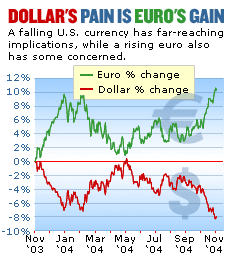NEW YORK (CNN/Money) - For most Americans, a record low for the dollar doesn't have the same urgency as soaring oil prices or a big tumble in the stock market.
But as the dollar broke through a new benchmark to trade at a record low level compared to the euro Wednesday, it's important to understand what that means to the economy -- and to you.
The value of the dollar affects everything from the price of consumer electronics and clothing, to mortgage rates and the job market, and to whether a vacation overseas is more affordable for Americans or Europeans.
The causes of the weak dollar are many, but economists agree on some major factors. And the general consensus is that the dollar won't climb out of its current position of weakness in the foreseeable future.
What causes weakness
The two factors most often pointed to are the U.S. trade deficit and the U.S. budget deficit.
The United States has run a trade deficit with the rest of the world for many years. And it has funded government spending deficits by issuing debt.
In the past, the dollar could stay strong in the face of those so-called "twin deficits" as long as there were strong levels of investment in U.S. bonds and equities by overseas governments and foreign investors.

In the last couple of years, however, increases in the trade and budget gaps have outstripped the flow of foreign dollars into the economy. Low interest rates in the United States have also slowed overseas investments here.
Bush administration officials have generally spoken out in favor of a strong dollar. But currency traders have interpreted the administration's actions -- as compared to its words -- as favoring a weaker dollar.
Besides running up the federal deficit, the administration has pushed hard for less intervention by Asian governments to keep their currencies weaker against the dollar.
How the weak dollar hurts the U.S.
If the weak dollar continues to hinder foreign investment in the United States, that could force up yields on government bonds, because higher rates would be needed to attract investors. And bond yields have a direct impact on a wide variety of interest rates paid by consumers and businesses, including mortgage rates.
The weak dollar also means many goods produced overseas with little domestic competition -- such as clothing or electronics -- could end up costing more here. And if Americans keep buying higher-priced imports, that could lead to an even larger trade deficit, which in turn would put further pressure on the dollar.
Click here to check currency rates
What's more, U.S. companies that buy raw materials and parts overseas would see costs rise in dollar terms. But if they can't raise prices for their products, that could cut into profits and perhaps, hiring.
One of the most direct effects: Americans traveling abroad would find prices for just about everything higher.
Benefits of a weaker dollar
There is some upside to dollar weakness, since many big U.S. companies get a bump in sales overseas, where their products become more competitive. For example, Procter & Gamble reported sales grew 3 percent in the third quarter due strictly to changes in currency exchange rates, bringing in an extra $365 million in company coffers.
And manufacturers such as U.S. automakers typically cheer a weaker dollar, even though the weakness tends to benefit producers of commodities such as steel more than makers of finished products such as autos.
U.S. tourism is another industry that can see a lift from a weaker dollar. Foreigners are more likely to visit because their home currencies can buy more here, and U.S. vacationers who might otherwise travel abroad are more likely to stay home if the weak dollar makes an overseas trip too costly.
What's next for the dollar?
"The consensus among currency traders for a continuing weakening of the dollar is overwhelming," said Ashraf Laidi, chief currency analyst for MG Financial Group. Laidi and others see relatively little on the horizon to help the dollar strengthen, although it is not widely expected to continue its decline of the last few months. Laidi sees the euro buying between $1.31 and $1.32 by the end of the year.
The dollar fell to another record low against the euro early Thursday, with the European currency buying $1.30 for the first time.
Tom Schlesinger, executive director of the Financial Markets Center, said without one of the two "twin deficits" showing signs of shrinking, there's little that would lift the dollar.
"Traders would want to see a drop in the price of oil (which could narrow the trade gap) or some major policy move in Washington that they would take as a serious sign of deficit cutting," he said. "If you had to handicap the two, a drop in oil prices is somewhat more likely."
The trade deficit could also decline if China allows its currency, the yuan, to move more freely in the markets, rather than being linked to the dollar. Such a move is possible late next year or early in 2006, according to economists.
That would make Chinese goods more expensive and limit Chinese exports to the United States, which has its largest trade gap with China. But in the short-term, such an increase in the value of the yuan would probably put additional downward pressure on the dollar.

|

